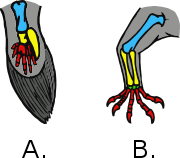Flipper (anatomy)
For the fish appendage, see Fish fin.

Penguin swimming. What is considered a "vestigial" wing is in fact a very effective flipper.
A flipper is a typically flat forelimb evolved for movement through water. Various creatures have evolved flippers, for example penguins (also called "wings"), cetaceans (e.g. dolphins and whales; usually called "fins"), pinnipeds, and reptiles such as some varieties of turtle and the now-extinct plesiosaurs, mosasaurs, ichthyosaurs, and metriorhynchids.
Some flippers are very efficient hydrofoils, analogous to wings (airfoils), used to propel and maneuver through the water with great speed and maneuverability (see Foil (fluid mechanics)). Some flippers are less foiled, with the appendages still apparent, as in the webbed forefeet seen in amphibious turtles.
See also
References
This article is issued from Wikipedia - version of the 7/26/2016. The text is available under the Creative Commons Attribution/Share Alike but additional terms may apply for the media files.

